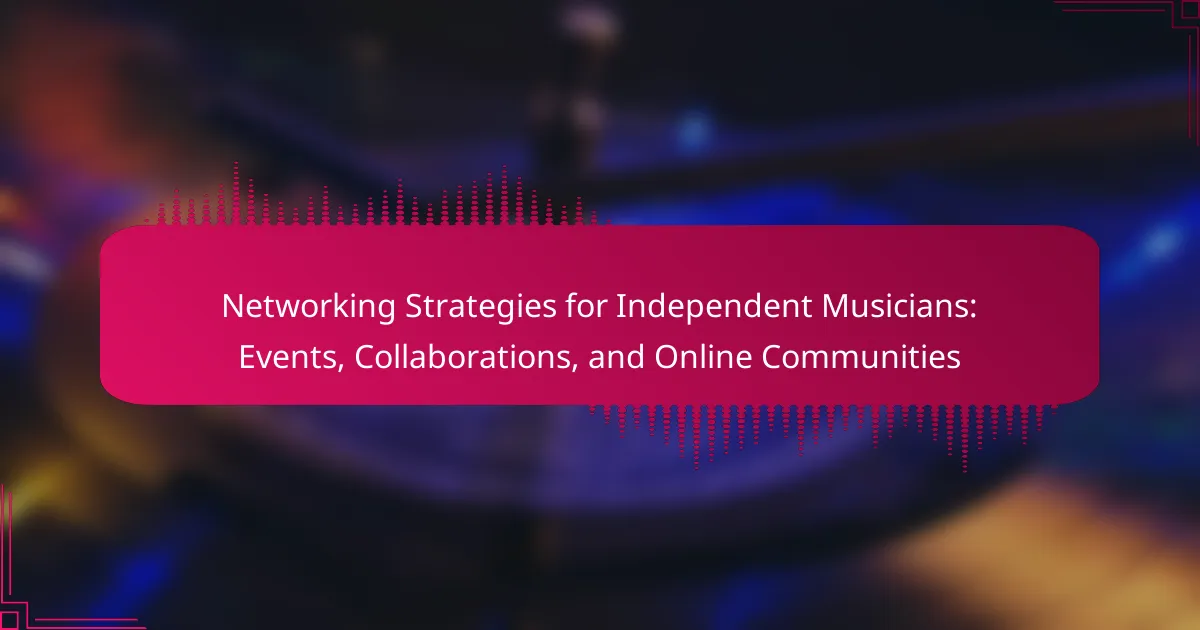Independent musicians often struggle with visibility and revenue in a competitive digital landscape. Digital distribution services provide essential features like global reach, royalty collection, and analytics. Key platforms such as DistroKid, TuneCore, and CD Baby offer varying pricing models and unique attributes. Understanding these differences is crucial for artists to maximize their exposure and earnings.
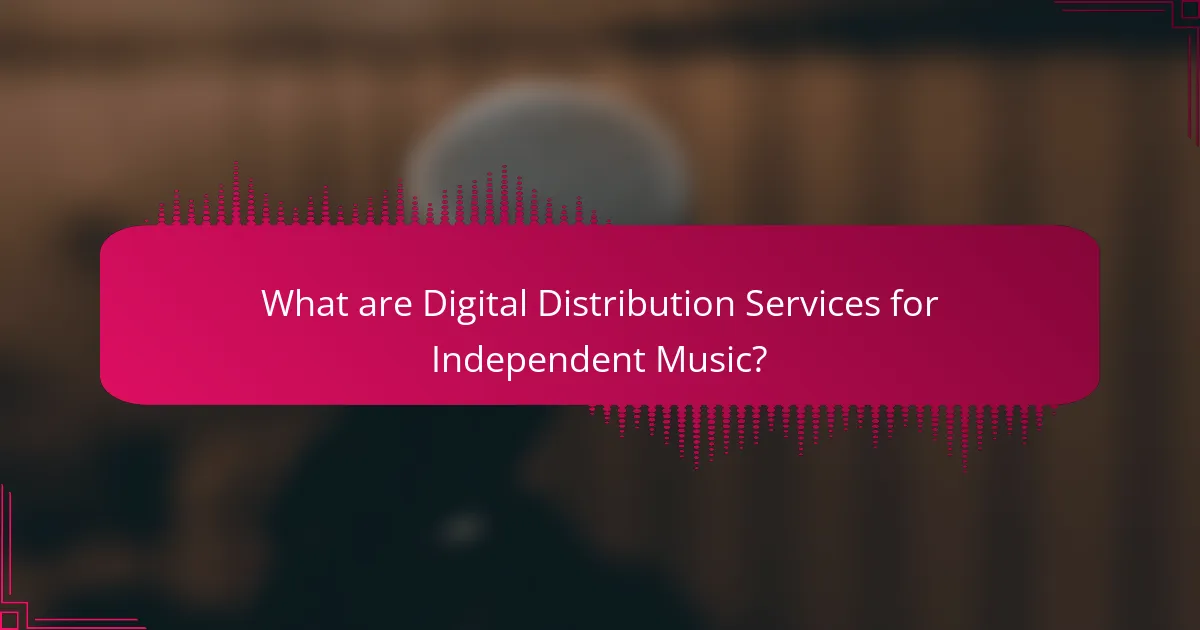
What are Digital Distribution Services for Independent Music?
Digital distribution services for independent music enable artists to distribute their music online effectively. These services offer features like global reach, royalty collection, and analytics. Pricing models vary, often including subscription fees or percentage cuts from sales. Popular services include DistroKid, TuneCore, and CD Baby, each with unique attributes such as speed of distribution and additional promotional tools.
How do these services work for independent artists?
Digital distribution services empower independent artists by providing platforms to release and monetize their music. These services streamline the process of getting music onto major streaming platforms, enabling artists to reach wider audiences without traditional label support.
Services typically offer features like track distribution, royalty collection, and analytics. For instance, platforms may charge a flat fee or take a percentage of earnings, which can vary significantly. Some services also provide promotional tools and marketing resources, enhancing an artist’s visibility.
The unique attribute of these services is their accessibility, allowing artists to retain ownership of their work while gaining exposure. As a result, independent artists can effectively manage their careers and revenue streams in a competitive music landscape.
What are the primary platforms available for digital distribution?
The primary platforms available for digital distribution include DistroKid, TuneCore, CD Baby, and Amuse. Each service offers unique features tailored for independent musicians.
| Platform | Key Features | Pricing Structure |
|————-|———————————-|————————|
| DistroKid | Unlimited uploads, fast payouts | Annual fee, no commission |
| TuneCore | Global distribution, detailed analytics | Per release fee, no annual fee |
| CD Baby | Physical distribution, sync licensing | One-time fee per release |
| Amuse | Free distribution, artist-friendly | Revenue share model |

What key features should independent musicians consider when choosing a service?
Independent musicians should prioritize key features like pricing, distribution reach, and royalty rates when choosing a digital distribution service. These factors directly impact their revenue and audience exposure.
Pricing models vary; some services charge upfront fees while others take a percentage of sales. Distribution reach is critical as it determines the platforms where music is available. Royalty rates affect how much musicians earn per stream or sale, making it essential to compare these rates across services.
Additional features to consider include user-friendly interfaces, promotional tools, and customer support quality. Some services offer unique attributes like advanced analytics or sync licensing opportunities, which can enhance an artist’s marketability.
How does pricing vary across different distribution services?
Pricing for digital distribution services varies significantly based on features and services offered. Services typically charge a flat fee, percentage of sales, or both. For example, platforms like DistroKid offer unlimited uploads for an annual fee, while TuneCore charges per release. Factors influencing pricing include distribution reach, royalty splits, and additional marketing tools. Independent artists should compare these elements to find the best fit for their needs.
What additional services do distributors offer beyond music distribution?
Distributors offer various additional services beyond music distribution, enhancing artists’ visibility and revenue. These services include marketing support, royalty management, playlist placements, and sync licensing opportunities.
Marketing support helps artists promote their music across digital platforms, increasing reach. Royalty management ensures accurate tracking and payment of earnings from various streams. Playlist placements can significantly boost an artist’s exposure by featuring their music in popular playlists. Sync licensing connects artists with opportunities to have their music used in films, commercials, and other media, generating additional income.
These services are crucial for independent artists aiming to navigate the competitive music landscape effectively.
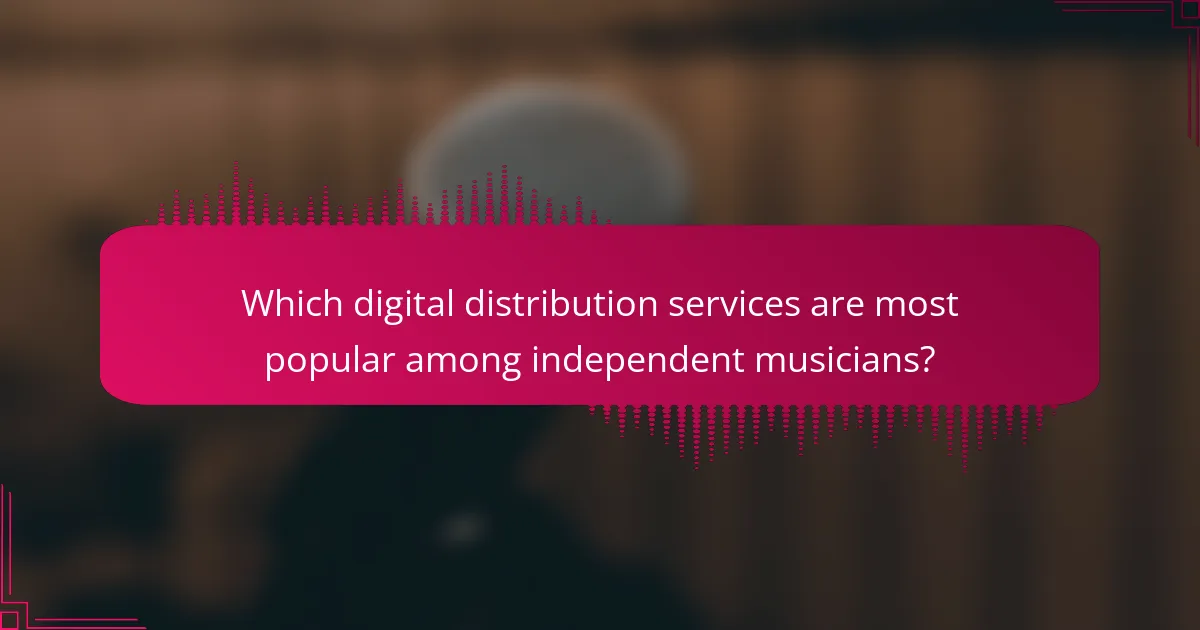
Which digital distribution services are most popular among independent musicians?
DistroKid, CD Baby, and TuneCore are among the most popular digital distribution services for independent musicians. DistroKid offers unlimited uploads for a flat annual fee, making it cost-effective. CD Baby provides a one-time fee per release, allowing artists to keep 100% of their royalties. TuneCore charges per release but offers additional promotional tools. Each service has unique features that cater to different needs, such as revenue splits, speed of distribution, and access to analytics.
What are the user experiences with top platforms like DistroKid and TuneCore?
User experiences with DistroKid and TuneCore vary significantly. DistroKid is praised for its user-friendly interface and quick distribution process, allowing artists to upload music and see it live on platforms swiftly. In contrast, TuneCore offers detailed analytics and comprehensive marketing tools, appealing to artists seeking in-depth insights into their performance.
Pricing is another differentiator; DistroKid charges an annual fee with unlimited uploads, while TuneCore operates on a per-release basis, which can be more costly for frequent releases. Users often highlight DistroKid’s faster customer support response times, whereas TuneCore users appreciate the extensive resources available for independent artists.
Overall, the choice between DistroKid and TuneCore often depends on individual artist needs, such as budget, desired features, and distribution frequency.
How do regional preferences influence the choice of distribution services?
Regional preferences significantly impact the choice of distribution services for independent music. Different regions favor specific platforms based on local music scenes, cultural trends, and audience demographics. For instance, artists in Europe may prefer services that cater to local genres like electronic or folk music, while North American artists might lean towards mainstream platforms that support a diverse range of styles.
Additionally, pricing models can vary regionally, affecting artist decisions. Some platforms offer lower fees or higher revenue shares in specific areas to attract local talent. As a result, understanding these regional dynamics is crucial for independent musicians seeking effective distribution channels.
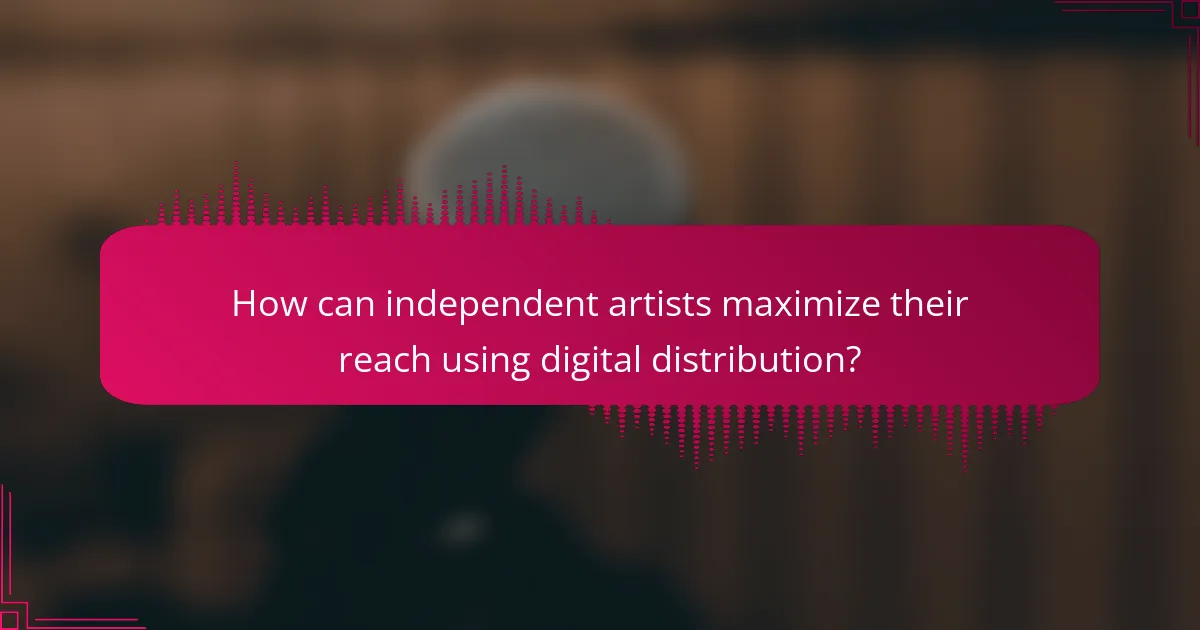
How can independent artists maximize their reach using digital distribution?
Independent artists can maximize their reach using digital distribution by selecting the right platforms and leveraging their features. Key services include DistroKid, TuneCore, and CD Baby, each offering unique pricing and distribution options.
DistroKid provides unlimited uploads for a flat annual fee, making it cost-effective for prolific artists. TuneCore charges per release but offers extensive global reach and detailed analytics. CD Baby combines physical and digital distribution, catering to artists seeking diverse formats.
By understanding these options, artists can choose services that align with their goals, ensuring their music reaches broader audiences efficiently.
What strategies enhance visibility on streaming platforms?
To enhance visibility on streaming platforms, utilize targeted marketing strategies and optimize content distribution. Focus on leveraging social media engagement and playlist placements. Collaborate with influencers to reach wider audiences and consider data analytics for audience insights. Consistent branding across platforms also improves recognition and discoverability.
How important is social media integration for distribution success?
Social media integration is crucial for distribution success in independent music. It enhances visibility and audience engagement, driving streams and sales. Effective integration can lead to increased fan interaction, allowing artists to share content directly and build a loyal following. Platforms like Instagram and TikTok enable artists to showcase their work, leading to viral moments that significantly boost track performance. Additionally, analytics from social media can inform marketing strategies, optimizing promotional efforts and maximizing reach.
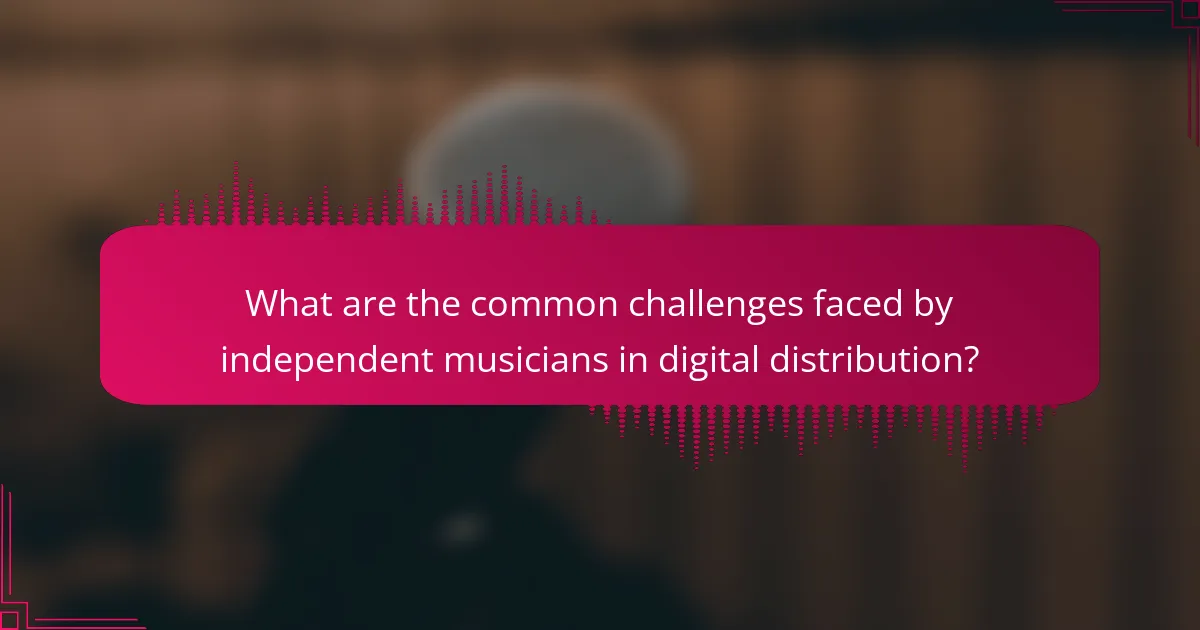
What are the common challenges faced by independent musicians in digital distribution?
Independent musicians face several challenges in digital distribution, including limited visibility, high competition, and complex royalty structures. These obstacles hinder their ability to reach audiences and generate revenue effectively. Many musicians struggle with understanding distribution agreements and navigating multiple platforms, which can lead to lost opportunities. Additionally, the lack of marketing resources often prevents them from promoting their music effectively, impacting their overall success in the digital landscape.
How can artists overcome issues related to copyright and licensing?
Artists can overcome copyright and licensing issues by utilizing digital distribution services that provide clear licensing terms and rights management. These services often include features that simplify the process of obtaining necessary permissions for music use.
Independent artists should compare services based on their pricing, features, and support for copyright claims. For instance, platforms like DistroKid and TuneCore offer various pricing models and additional services such as music publishing administration.
Understanding the unique attributes of each service, such as their royalty distribution methods and customer support, can help artists make informed decisions. Additionally, leveraging resources like legal advice or copyright registration can further protect their work.
By actively engaging with these digital distribution services, artists can effectively navigate the complexities of copyright and licensing while maximizing their reach and revenue.
What are the pitfalls of using multiple distribution services?
Using multiple distribution services can lead to inconsistencies in branding, revenue fragmentation, and complex reporting. Independent musicians may find it challenging to manage various platforms effectively. This can result in missed opportunities for promotion and audience engagement. Additionally, overlapping distribution fees may reduce overall earnings, complicating financial management.
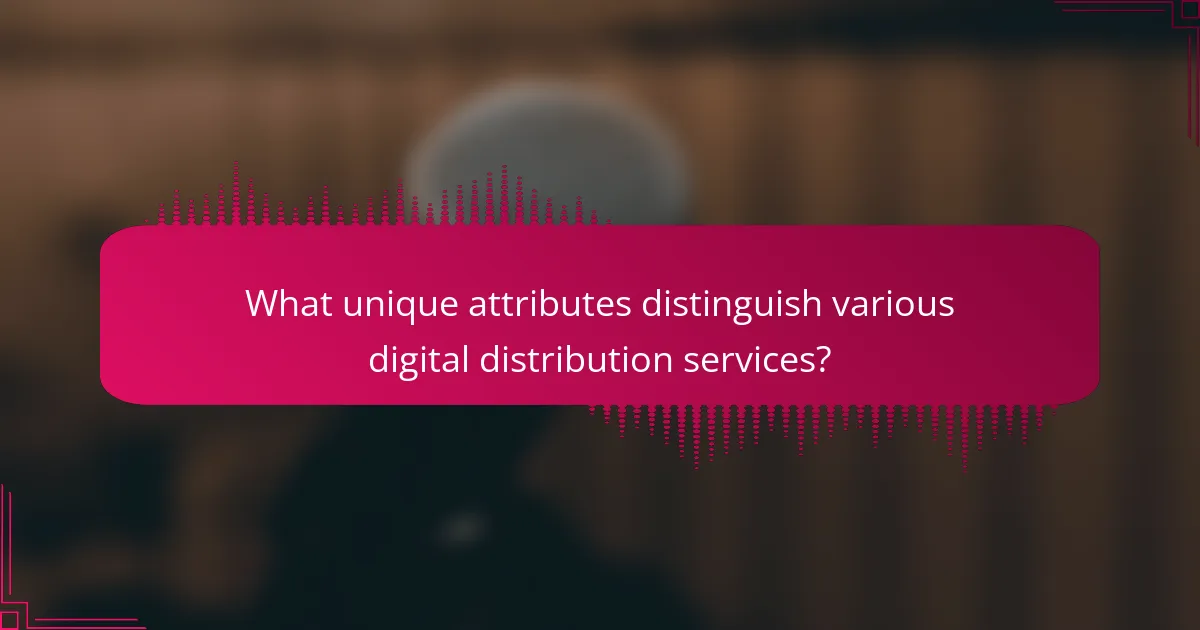
What unique attributes distinguish various digital distribution services?
Digital distribution services for independent music differ in unique attributes like royalty rates, distribution speed, and platform reach. These factors significantly impact an artist’s exposure and earnings. For instance, some services offer higher royalty percentages but may have longer distribution times. Others provide extensive global reach, which can enhance an artist’s visibility. Notably, unique features such as data analytics tools or promotional support also set services apart. Understanding these distinctions helps artists choose the best platform for their needs.
How do some platforms cater specifically to niche genres or audiences?
Digital distribution services cater to niche genres by offering tailored features and pricing models that resonate with specific audiences. These platforms often include genre-specific playlists, targeted marketing tools, and community engagement options. For instance, services like Bandcamp prioritize independent artists and niche genres, allowing for direct fan interaction and unique promotional opportunities. Additionally, platforms may provide flexible pricing structures, enabling artists to choose plans that best suit their audience size and engagement level.
What innovative features are emerging in the digital distribution landscape?
Innovative features in digital distribution for independent music include enhanced analytics, automated royalty payments, and customizable marketing tools. These advancements improve artist engagement and streamline revenue generation. For example, real-time data insights allow artists to track listener demographics and optimize promotional strategies effectively. Additionally, some platforms now offer AI-driven music recommendations, enhancing discoverability for independent artists.
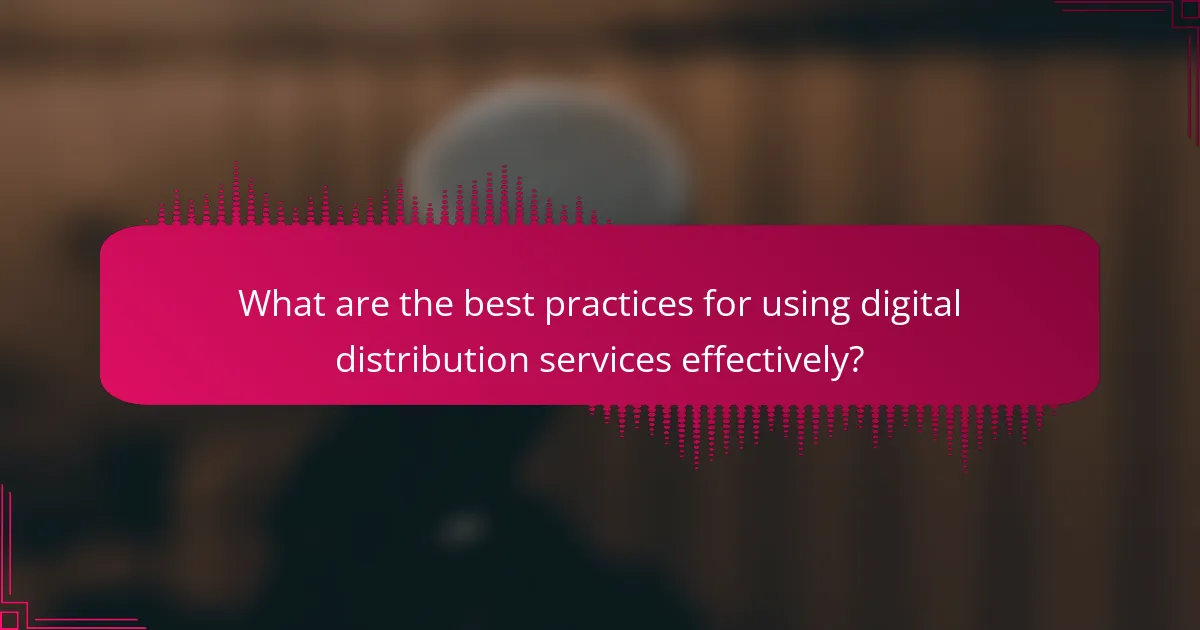
What are the best practices for using digital distribution services effectively?
To use digital distribution services effectively, focus on selecting the right platform, understanding pricing structures, and utilizing marketing tools. Choose a service that aligns with your music genre and audience. Compare features such as royalty rates, distribution reach, and user interface. Leverage promotional tools offered by platforms to enhance visibility. Regularly analyze performance metrics to refine your strategy.
What common mistakes should independent musicians avoid?
Independent musicians should avoid common mistakes like neglecting digital distribution, overlooking promotional strategies, and failing to understand pricing structures. Prioritizing a reliable distribution service ensures better reach and revenue. Many musicians underestimate the importance of marketing, which is crucial for visibility. Additionally, understanding the fees associated with various services helps in budgeting effectively.
How can artists track and analyze their distribution performance?
Artists can track and analyze their distribution performance through digital distribution services that offer analytics tools. These tools provide insights into streaming numbers, geographic reach, and audience demographics. Services like DistroKid, TuneCore, and CD Baby each have unique features, such as real-time data access and revenue tracking. By comparing these features, artists can choose a service that best meets their needs for performance analysis.


